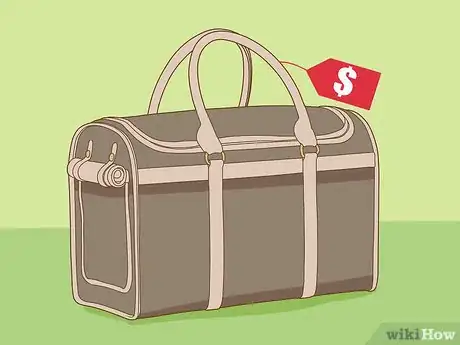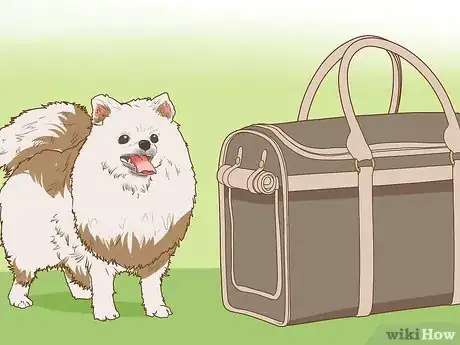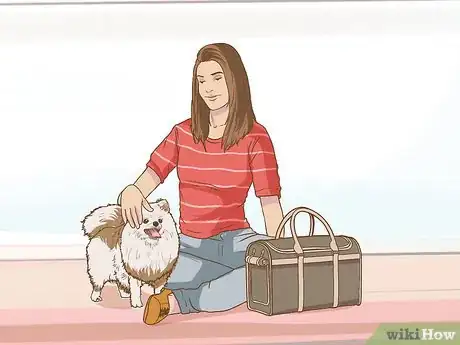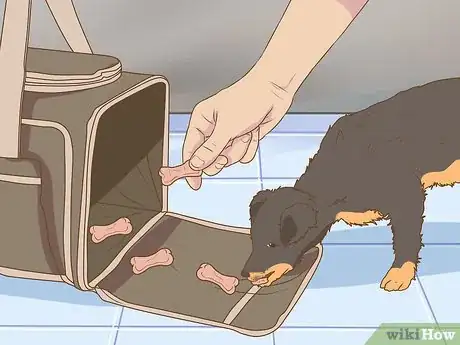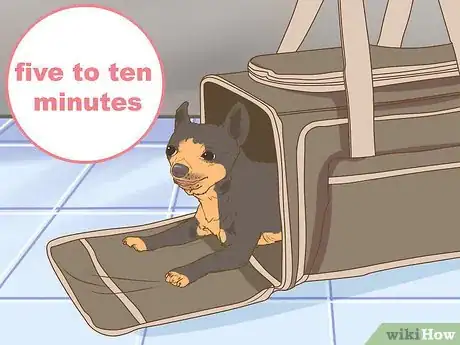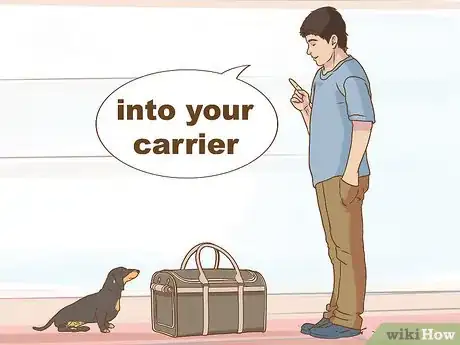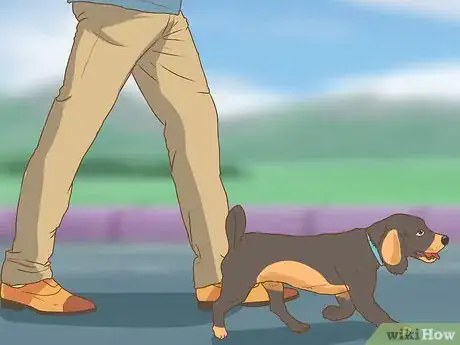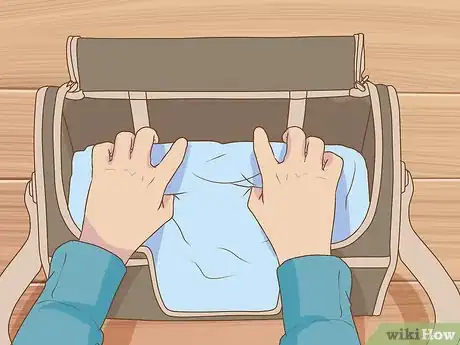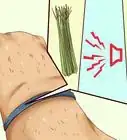This article was co-authored by Indigo Will. Indigo Will is a Canine Expert, Trainer, and Founder and Owner of K9-INDIGO® Holistic Dog Training LLC™, a dog training service in Los Angeles, California. Indigo specializes in understanding canine temperament and dispositions to allow canines to reach their full potential. He has studied various methods of training and philosophies to develop a unique, innovative, and result-driven method for canine behavior training.
This article has been viewed 34,426 times.
Many people want to have their furry friend with them at all times. And increasingly small dogs are accompanying their owners to the mall, coffee shop, grocery store, etc. In order to make this happen, your dog will need to become comfortable riding in a carrier bag. The best way to teach your dog to ride in a carrier is through exposure, rewards, and travelling short distances.
Steps
Introducing Your Dog to the Carrier
-
1Buy a carrier that fits your dog. Measure your dog from the ground to the top of its shoulders. This is the key measurement to consider when buying a carrier and represents your dog's height. You also want to make sure that the carrier is long enough for your dog to turn around. Measure your dog from the tailbone to the tip of the nose.
-
2Expose your dog to the carrier. Before you can expect your dog to ride in its carrier, you need to introduce your dog to it. This should be done a few weeks prior to any major travel. Place the carrier in a central spot in your home, preferably somewhere the dog normally hangs out. For example, you could put the carrier near the dog’s bed or toys.[1]
- You can also try using an excited voice when you get out the carrier. This way the dog will have a positive association with the new item.
Advertisement -
3Play with your dog near the carrier. This will help get your dog comfortable near the carrier. It will also begin to realize that the carrier is not threatening. For example, you could play fetch or tug-of-war beside the carrier. The more positive exposure your dog has with the carrier, the more comfortable it will be.
-
4Use treats to lure the dog into the carrier. Provide your dog with an opportunity to explore the carrier on its own terms. For example, open or remove the door of the carrier and put a few treats inside. Let the dog go over to the carrier and explore it at its own pace.
- Never push or force the dog into the carrier.
-
5Put your dog in the carrier for short periods of time.[2] Get your dog comfortable with the carrier by putting your dog in it for five to ten minutes at a time. At first, you should stay with the dog for comfort. Place the carrier at your feet and talk to your dog so it does not feel alone.
- As this become easier, increase the time the dog is in the carrier by 15 minute intervals. Continue to increase the time, until the dog is comfortable in the carrier for an hour.
- Once your dog is more comfortable, you can try leaving the room for short periods of time.
Training Your Dog to Ride in a Carrier
-
1Come up with a command word. You can train your dog to enter the carrier without treats, by using a command word. For example, you could say something like “go in your carrier” or “into your carrier.” Always use the exact same command when you are training your dog. If you switch between commands, the dog will become frustrated and confused.
-
2Train your dog to enter the carrier on command. Hold a treat in your hand and say “go in your carrier.” Then place the treat in the carrier. Once the dog goes into the carrier, reward them with another treat.[3]
- Eventually your dog will associate the command with the act of entering the carrier.
- Begin by practicing the command without closing the dog in the carrier. As it gets more comfortable, you can close the carrier with the dog inside.
-
3Take your dog on short trips. Before embarking on a long trip, get your dog comfortable traveling inside the carrier. Take your dog to fun places, like the dog park, using the carrier. This way the dog will associate the carrier with positive trips and experiences.
- If you plan on taking your dog on a plane, you should take them on a car ride in the carrier first. This will help them get used to the engine noise and motion.
- Every time your dog takes a trip in the carrier reward it with treats and praise.
Travelling with a Dog in a Carrier
-
1Give the dog plenty of exercise before traveling long distances. If you are traveling a long distance, make sure that your dog gets plenty of exercise before the trip. This will tire your dog out and it will likely fall asleep while travelling. You do not want your dog to be restless and whine in the carrier.[4]
- It is also a good idea to remove their water 2 hours before a trip. This will help prevent the dog from going to the bathroom in the carrier.
-
2Cover the bottom of the carrier with blankets or a mat.[5] You want to make the carrier a comfortable place for your dog. Line the bottom of the carrier with blankets. If your dog has a favourite blanket that they are used to sleeping with, place it in the carrier.
- Do not wash your dog’s blanket. The familiar smell can actually help comfort them while they are in the carrier.
-
3Put your dog’s favourite toy in the carrier.[6] Place a toy, such as a stuffed animal in the carrier. This will give your dog something to play with or snuggle with while they are traveling. It will also help to comfort them and may even reduce their anxiety.
-
4Ask your veterinarian about sedatives. If your dog is unable to relax while traveling in the carrier, you may want to talk to your veterinarian about sedatives. Your vet will need to assess your dog’s health and determine if a sedative is appropriate. You may also want to test a dose at home before traveling in order to determine the effect the sedative will have on your dog.[7]
Expert Q&A
-
QuestionHow can I reduce my dog's anxiety in his carrier?
 Indigo WillIndigo Will is a Canine Expert, Trainer, and Founder and Owner of K9-INDIGO® Holistic Dog Training LLC™, a dog training service in Los Angeles, California. Indigo specializes in understanding canine temperament and dispositions to allow canines to reach their full potential. He has studied various methods of training and philosophies to develop a unique, innovative, and result-driven method for canine behavior training.
Indigo WillIndigo Will is a Canine Expert, Trainer, and Founder and Owner of K9-INDIGO® Holistic Dog Training LLC™, a dog training service in Los Angeles, California. Indigo specializes in understanding canine temperament and dispositions to allow canines to reach their full potential. He has studied various methods of training and philosophies to develop a unique, innovative, and result-driven method for canine behavior training.
Professional Canine Expert Try to make his carrier as comfortable as possible. I would put in a mat to sit on and his favorite toy. It will also help to introduce him to the carrier before a trip so he can get used to it. Leave the kennel out with the door open and praise your dog whenever he goes into it.
Try to make his carrier as comfortable as possible. I would put in a mat to sit on and his favorite toy. It will also help to introduce him to the carrier before a trip so he can get used to it. Leave the kennel out with the door open and praise your dog whenever he goes into it.
Warnings
- Do not put your dog in a new carrier on the day of a long trip. The new environment may cause your dog anxiety.[8]⧼thumbs_response⧽
References
- ↑ http://prettyfluffy.com/home-living/tips-training/introducing-your-dog-to-a-carrier
- ↑ Indigo Will. Professional Canine Expert. Expert Interview. 8 September 2020.
- ↑ https://www.youtube.com/watch?v=FGn1ujtZJ2s
- ↑ http://travel.barkpost.com/tips-traveling-plane/
- ↑ Indigo Will. Professional Canine Expert. Expert Interview. 8 September 2020.
- ↑ Indigo Will. Professional Canine Expert. Expert Interview. 8 September 2020.
- ↑ http://www.vcahospitals.com/main/pet-health-information/article/animal-health/air-and-car-travel-in-dogs-behavior-and-training/150
- ↑ http://www.whole-dog-journal.com/issues/17_5/features/Preparing-to-Fly-With-Your-Dog_20975-1.html
About This Article
To get your dog to ride in a carrier, expose it to the carrier a few weeks before traveling. Try placing the carrier near your dog's bed or toys and use an excited voice when you get it out so your dog can associate it with a positive experience. Once your pup is more comfortable around the carrier, lure it in with a trail of treats and let it explore the carrier at its own pace. As it becomes easier to get your dog in, let it stay in the carrier for 5 to 10 minutes at a time while you talk to it so it doesn’t feel alone. From there, slowly increase the time in the carrier by 15 minute intervals until your dog is comfortable being in it for a full hour. For more advice, like how to make your dog comfier and relaxed during travel, read on!
